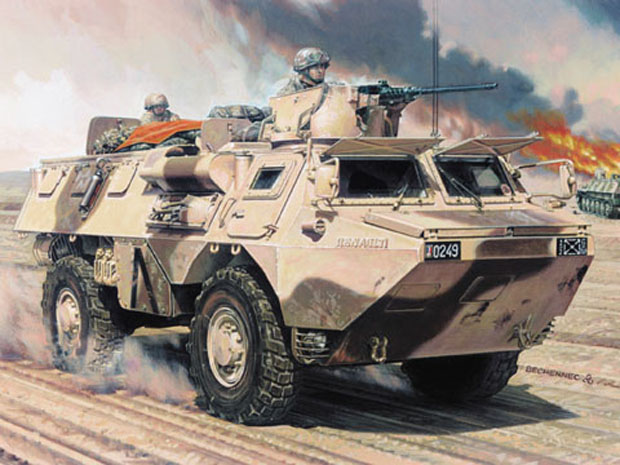French Renault Saviem VAB 4×4 Armoured Personnel Carrier
Heller 1:72 Scale Vehicle Review

The armoured troop transport VAB 4×4 by Heller represents an APC of 2nd Company, 2nd Infantry Regiment of the French Foreign Legion. This unit was part of the French Division Daquet which fought in the 1991 Gulf War. Division Daquet was among the troops which penetrated most deeply into Iraq. French vehicles used in the Gulf War were originally painted in the three-colour "Centre Ouest" camouflage pattern for Central and Western Europe, the light green and black camouflage patches of which were covered with sandcoloured paint. This camouflage pattern was unique to Division Daquet. The regulation desert camouflage pattern requires that the black camouflage patches are only partially overpainted with sandcoloured paint.
Evaluation
Excellent choice of subject, the VAB 4×4 is a standard vehicle of the French army, and it has many interesting variants.
Only 39 parts, the VAB can be built in less than an hour. Significantly more time may be spent superdetailing the vehicle with scratchbuilt replacement parts and accessories.
The kit incluces all windows of the VAB. The model should be airbrushed prior to final assembly, otherwise the windows need to be masked.
One of the three roof hatches of the fighting compartment, and the armoured shutters in front of the windows may be modelled in the open or closed position. However, when the hatches are open, enough light falls inside to reveal that the vehicle has no crew or interior.
According to the instructions, the machine gun turret shall be permanently glued to the hull. This is not strictly necessary. The turret stays on even without glue. With a little extra effort, the turret could be secured from inside the vehicle in such a way that it still turns.
Compatible with ESCI, Hasegawa, and Revell.
The machine gun turret hatch is modelled in the closed position, unfortunately. It will require some modelling effort to scratchbuild an open hatch. If suitable crew figures were available, this modification would be well worth the extra work.
The splash board (№ 21) is modelled in the open position. To modelt he splash board in the stowed position, the clear top section needs to be cut off.
The tire tread does not represent the Michelin tire used on the VAB, and which is shown correctly on the box cover. When viewed from the side, the tire looks like a re-tread.
The large tires of the VAB are not deformed at all, although one would expect some flattening due to the vehicle’s battle weight of 13 t. Purists may want to flatten the tires appropriately, using a hotplate or heated spatula. Replacement wheels made from resin or metal are another option.
The tow hooks at the front and rear, as well as the lift hooks on the hull sides are missing. These parts may be scratchbuilt from brass wire.
The antenna mount on the driver’s side cannot be identified correctly in the instructions. In section 6 of the instructions there seems to be a black antenna mount above and to the right of the driver’s door, but this part has not been included in the kit. If this is the correct antenna location, a small antenna mount may be scratchbuilt from plastic sprue or brass, and the antenna inserted into it.
The cast-on handholds next to the doors should be replaced by more realistic parts made from brass wire.
Unfortunately, the windshield wipers are not included in the kit, and they have not been cast into the clear windshield parts as can be seen on some other kits.
The painting on the box cover shows the VAB with external stowage on the roof which has not been included in the kit, unfortunately. Camouflage netting, sleeping bags, and aerial recognition panels can be made from tissue paper and tied to the roof with thread.
The instructions only show the two-colour desert camouflage pattern used during the Gulf War. Anyone interested in painting the VAB in the more common three-colour camouflage pattern of the Franco-German Brigade, will have to find painting instructions elsewhere.
The kit includes no decals for a VAB of the Franco-German Brigade. Manufacturers often sell their scale models with a meagre selection of decals, and they completely overlook the market potential of a particular kit. If the VAB were available with a complete set of license plates and tactical markings of an entire French mechanized infantry platoon, many collectors and wargamers would raise entire units rather than just build a single vehicle.
Driver and vehicle commander are not included. None of the popular manufacturers offer French infantry and vehicle crew in 1:72 scale yet. Modellers and wargamers will have to improvise or look for small run resin or metal models of French troops.
Heller’s VAB scales out 14 cm longer and 11 cm wider than the original. The vehicle’s wheelbase is 14 cm too long as well. These discrepancies amount to less than one percent, and they will hardly be noticeable to the casual observer.
The VAB amphibious armoured transport by Heller is a nice model for wargames and diorama builders interested in the modern French army. The VAB has over 50 variants, many of which may be built from this kit. A waterline model of the VAB may be created by cutting the hull at the waterline and mounting the vehicle on a river base.